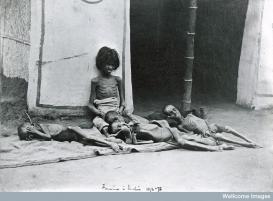The visual documentation of famine in nineteenth-century India provides a frame for understanding how modalities of classification, institutional practices, and visual technologies organizes forms of knowledge and colonial governance in the treatment of a specific problem: hunger and famine. Images of famine were incorporated into the colonial archive in 1876, with the photographic testament of the Madras famine by Willoughby Wallace Hooper, a military officer of the 7th Madras Light Cavalry. The archive expanded in the next decade, and by the 1890s, with the introduction of the cheap handheld Kodak camera, famine photography ascended in journalistic importance and emerged within the illustrated periodical press.
This research seeks to offer an insight into the visual documentation of famine in India from 1870–1920, and more broadly on the colonial state’s attempt to create an archive, in numerous modes—visual, textual, and material—of famine as the “eternal” condition of India. The project operates from the premise that photography is a technology of visualization that both draws and establishes a “visual economy” through which issues are materialized in particular ways. The focus here is on the production of photographs, their circulation and the cultural resources and social systems through which images are interpreted and valued.
Particular attention will be paid to the complexities of photographic authorship and intentionality, the gradual shift in patronage from “official” or “court” photographers to independent practitioners, and the role of photographs in making suffering of others real to the distanced but engaged spectator. Central to discussions on photography as a technology of information are questions of spatial and temporal dimensions of photographic witnessing that had implications for shaping individual and collective memory.
Apart from the institutions that circulated famine images, this research encompasses individuals who collated accounts of famine into a system of documentation and display. The primary sources for the research include official reports and publications, private papers, newspapers, and photographs taken by colonial administrators, photojournalists, and Christian missionaries. The larger goal of the project is to associate the emergence of a visual culture of famine to the historical realities of imperialist expansion, the production of colonial knowledge on famine, and the discordant forms of subjectivity that found expression in this cultural arena.

